Business Report: Company Forms, Structures, and Tesco Analysis
VerifiedAdded on 2022/12/27
|11
|2724
|120
Report
AI Summary
This report delves into the multifaceted world of business, exploring the concepts of micro, small, medium, and large businesses, and their distinguishing characteristics. It examines various organizational forms, including sole traders, partnerships, and public limited companies like Tesco Plc, highlighting their operational differences and legal structures. The report further analyzes organizational structures such as hierarchical and divisional structures, and their impact on productivity within a company. A significant portion of the report is dedicated to a detailed PESTLE analysis of Tesco Plc, evaluating the political, economic, social, technological, legal, and environmental factors influencing the company's operations and performance. The report provides a comprehensive overview of business practices, offering insights into how companies adapt to their environments and maintain operational efficiency.
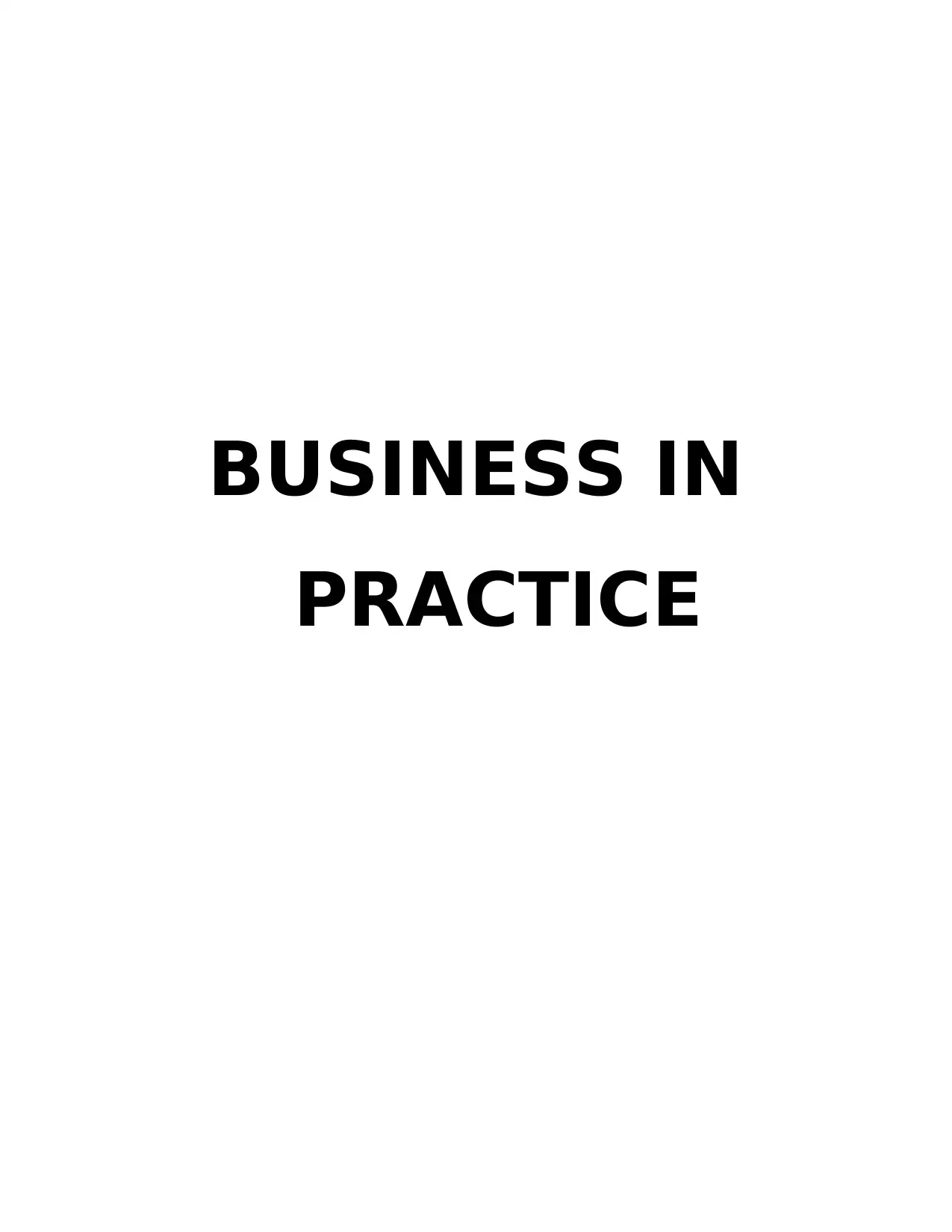
BUSINESS IN
PRACTICE
PRACTICE
Secure Best Marks with AI Grader
Need help grading? Try our AI Grader for instant feedback on your assignments.
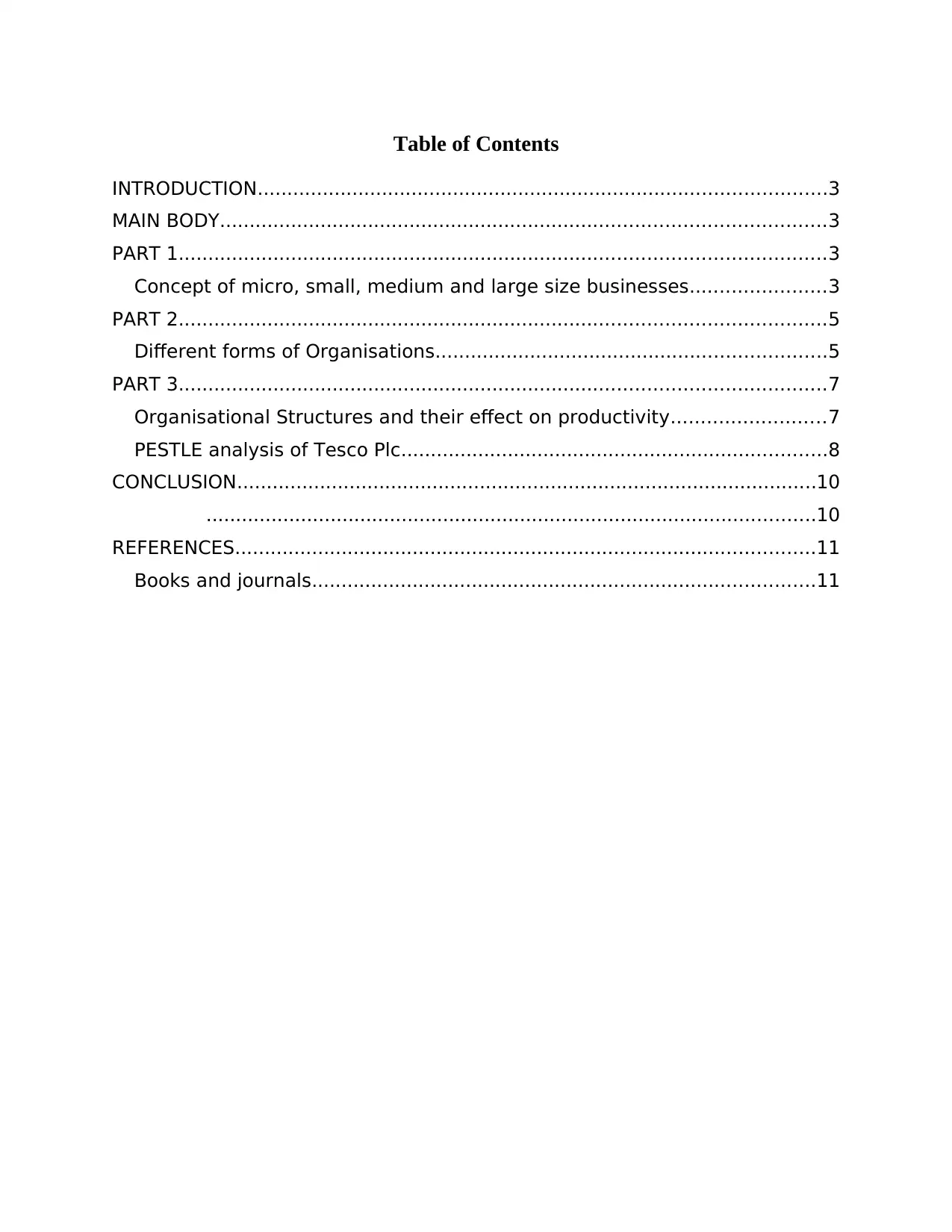
Table of Contents
INTRODUCTION................................................................................................3
MAIN BODY......................................................................................................3
PART 1.............................................................................................................3
Concept of micro, small, medium and large size businesses.......................3
PART 2.............................................................................................................5
Different forms of Organisations..................................................................5
PART 3.............................................................................................................7
Organisational Structures and their effect on productivity..........................7
PESTLE analysis of Tesco Plc........................................................................8
CONCLUSION..................................................................................................10
.......................................................................................................10
REFERENCES..................................................................................................11
Books and journals.....................................................................................11
INTRODUCTION................................................................................................3
MAIN BODY......................................................................................................3
PART 1.............................................................................................................3
Concept of micro, small, medium and large size businesses.......................3
PART 2.............................................................................................................5
Different forms of Organisations..................................................................5
PART 3.............................................................................................................7
Organisational Structures and their effect on productivity..........................7
PESTLE analysis of Tesco Plc........................................................................8
CONCLUSION..................................................................................................10
.......................................................................................................10
REFERENCES..................................................................................................11
Books and journals.....................................................................................11
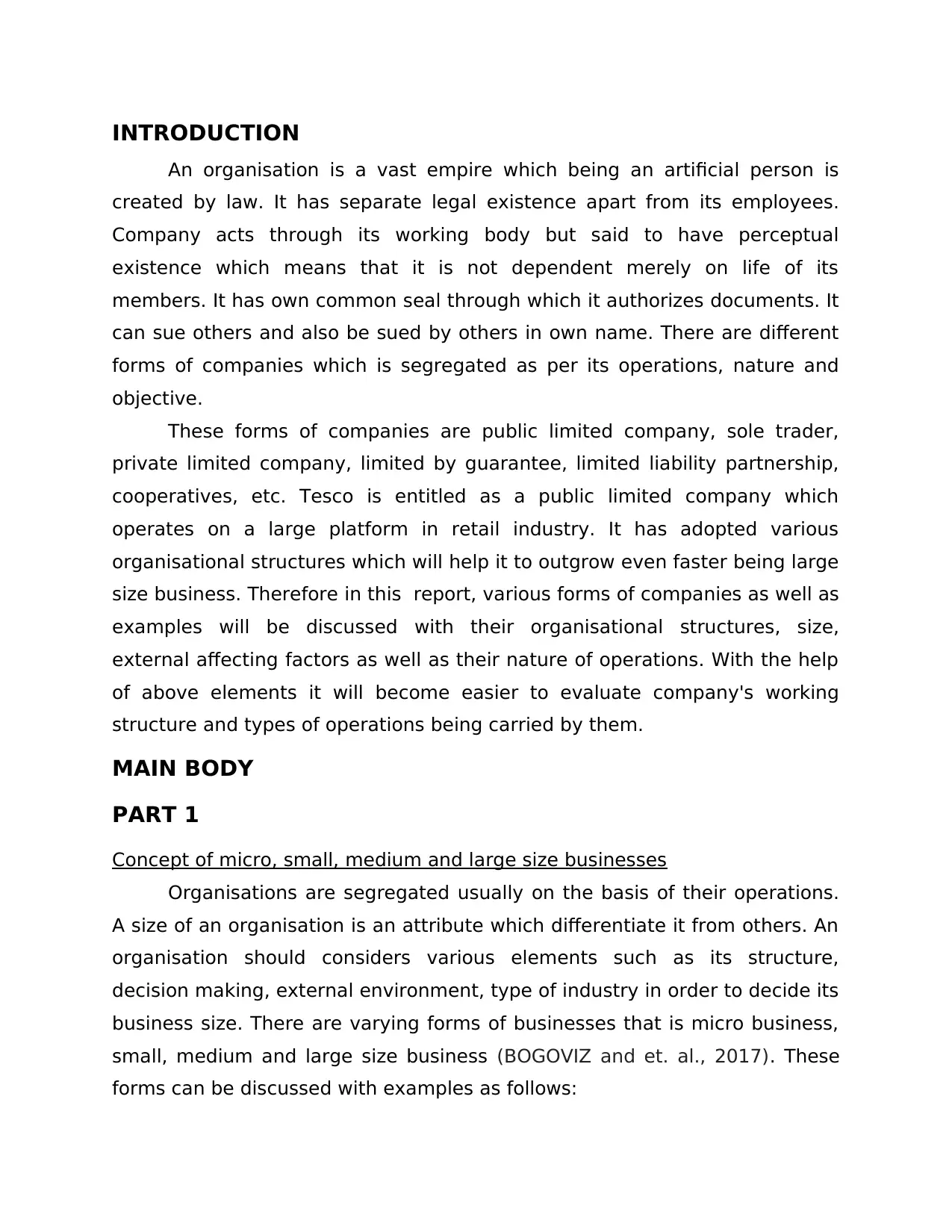
INTRODUCTION
An organisation is a vast empire which being an artificial person is
created by law. It has separate legal existence apart from its employees.
Company acts through its working body but said to have perceptual
existence which means that it is not dependent merely on life of its
members. It has own common seal through which it authorizes documents. It
can sue others and also be sued by others in own name. There are different
forms of companies which is segregated as per its operations, nature and
objective.
These forms of companies are public limited company, sole trader,
private limited company, limited by guarantee, limited liability partnership,
cooperatives, etc. Tesco is entitled as a public limited company which
operates on a large platform in retail industry. It has adopted various
organisational structures which will help it to outgrow even faster being large
size business. Therefore in this report, various forms of companies as well as
examples will be discussed with their organisational structures, size,
external affecting factors as well as their nature of operations. With the help
of above elements it will become easier to evaluate company's working
structure and types of operations being carried by them.
MAIN BODY
PART 1
Concept of micro, small, medium and large size businesses
Organisations are segregated usually on the basis of their operations.
A size of an organisation is an attribute which differentiate it from others. An
organisation should considers various elements such as its structure,
decision making, external environment, type of industry in order to decide its
business size. There are varying forms of businesses that is micro business,
small, medium and large size business (BOGOVIZ and et. al., 2017). These
forms can be discussed with examples as follows:
An organisation is a vast empire which being an artificial person is
created by law. It has separate legal existence apart from its employees.
Company acts through its working body but said to have perceptual
existence which means that it is not dependent merely on life of its
members. It has own common seal through which it authorizes documents. It
can sue others and also be sued by others in own name. There are different
forms of companies which is segregated as per its operations, nature and
objective.
These forms of companies are public limited company, sole trader,
private limited company, limited by guarantee, limited liability partnership,
cooperatives, etc. Tesco is entitled as a public limited company which
operates on a large platform in retail industry. It has adopted various
organisational structures which will help it to outgrow even faster being large
size business. Therefore in this report, various forms of companies as well as
examples will be discussed with their organisational structures, size,
external affecting factors as well as their nature of operations. With the help
of above elements it will become easier to evaluate company's working
structure and types of operations being carried by them.
MAIN BODY
PART 1
Concept of micro, small, medium and large size businesses
Organisations are segregated usually on the basis of their operations.
A size of an organisation is an attribute which differentiate it from others. An
organisation should considers various elements such as its structure,
decision making, external environment, type of industry in order to decide its
business size. There are varying forms of businesses that is micro business,
small, medium and large size business (BOGOVIZ and et. al., 2017). These
forms can be discussed with examples as follows:
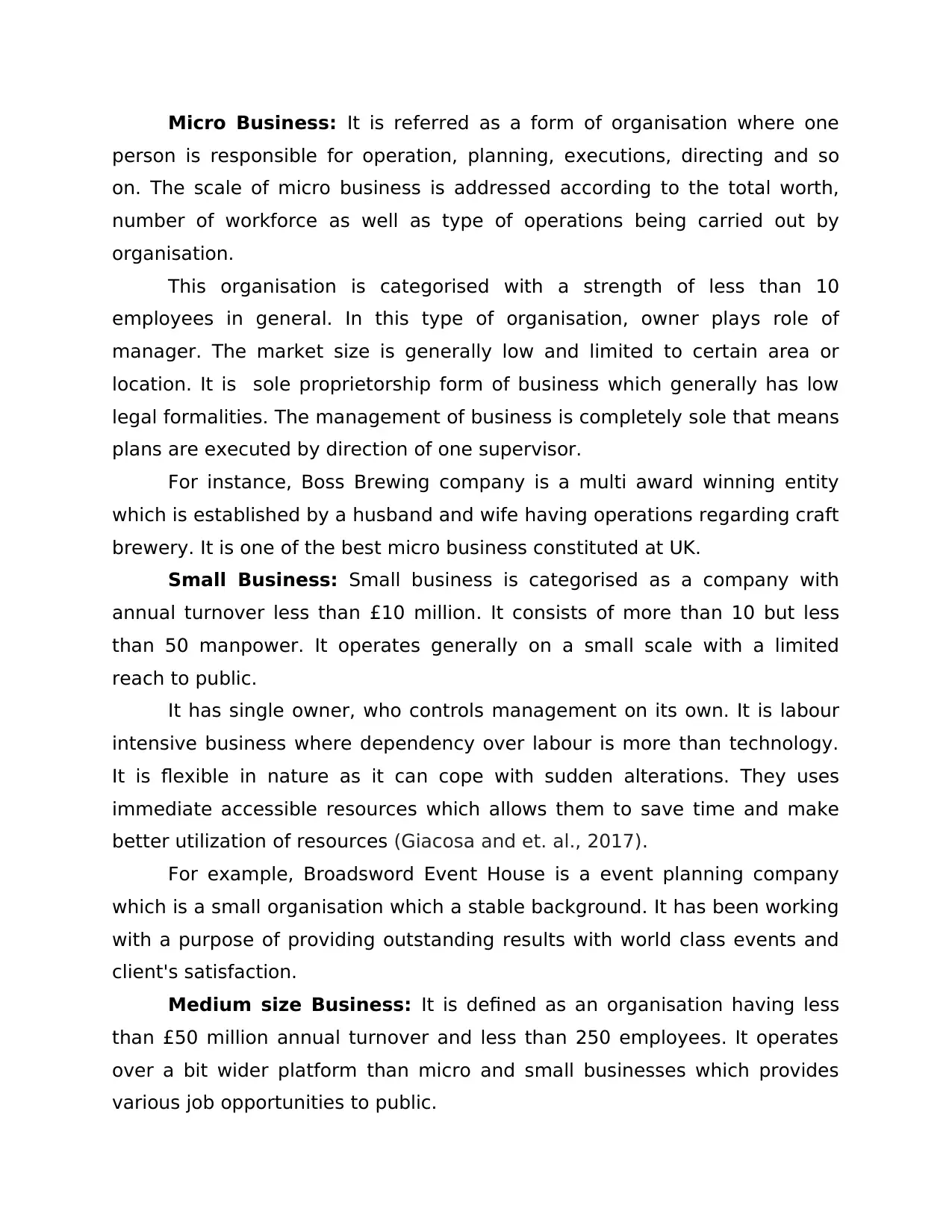
Micro Business: It is referred as a form of organisation where one
person is responsible for operation, planning, executions, directing and so
on. The scale of micro business is addressed according to the total worth,
number of workforce as well as type of operations being carried out by
organisation.
This organisation is categorised with a strength of less than 10
employees in general. In this type of organisation, owner plays role of
manager. The market size is generally low and limited to certain area or
location. It is sole proprietorship form of business which generally has low
legal formalities. The management of business is completely sole that means
plans are executed by direction of one supervisor.
For instance, Boss Brewing company is a multi award winning entity
which is established by a husband and wife having operations regarding craft
brewery. It is one of the best micro business constituted at UK.
Small Business: Small business is categorised as a company with
annual turnover less than £10 million. It consists of more than 10 but less
than 50 manpower. It operates generally on a small scale with a limited
reach to public.
It has single owner, who controls management on its own. It is labour
intensive business where dependency over labour is more than technology.
It is flexible in nature as it can cope with sudden alterations. They uses
immediate accessible resources which allows them to save time and make
better utilization of resources (Giacosa and et. al., 2017).
For example, Broadsword Event House is a event planning company
which is a small organisation which a stable background. It has been working
with a purpose of providing outstanding results with world class events and
client's satisfaction.
Medium size Business: It is defined as an organisation having less
than £50 million annual turnover and less than 250 employees. It operates
over a bit wider platform than micro and small businesses which provides
various job opportunities to public.
person is responsible for operation, planning, executions, directing and so
on. The scale of micro business is addressed according to the total worth,
number of workforce as well as type of operations being carried out by
organisation.
This organisation is categorised with a strength of less than 10
employees in general. In this type of organisation, owner plays role of
manager. The market size is generally low and limited to certain area or
location. It is sole proprietorship form of business which generally has low
legal formalities. The management of business is completely sole that means
plans are executed by direction of one supervisor.
For instance, Boss Brewing company is a multi award winning entity
which is established by a husband and wife having operations regarding craft
brewery. It is one of the best micro business constituted at UK.
Small Business: Small business is categorised as a company with
annual turnover less than £10 million. It consists of more than 10 but less
than 50 manpower. It operates generally on a small scale with a limited
reach to public.
It has single owner, who controls management on its own. It is labour
intensive business where dependency over labour is more than technology.
It is flexible in nature as it can cope with sudden alterations. They uses
immediate accessible resources which allows them to save time and make
better utilization of resources (Giacosa and et. al., 2017).
For example, Broadsword Event House is a event planning company
which is a small organisation which a stable background. It has been working
with a purpose of providing outstanding results with world class events and
client's satisfaction.
Medium size Business: It is defined as an organisation having less
than £50 million annual turnover and less than 250 employees. It operates
over a bit wider platform than micro and small businesses which provides
various job opportunities to public.
Secure Best Marks with AI Grader
Need help grading? Try our AI Grader for instant feedback on your assignments.
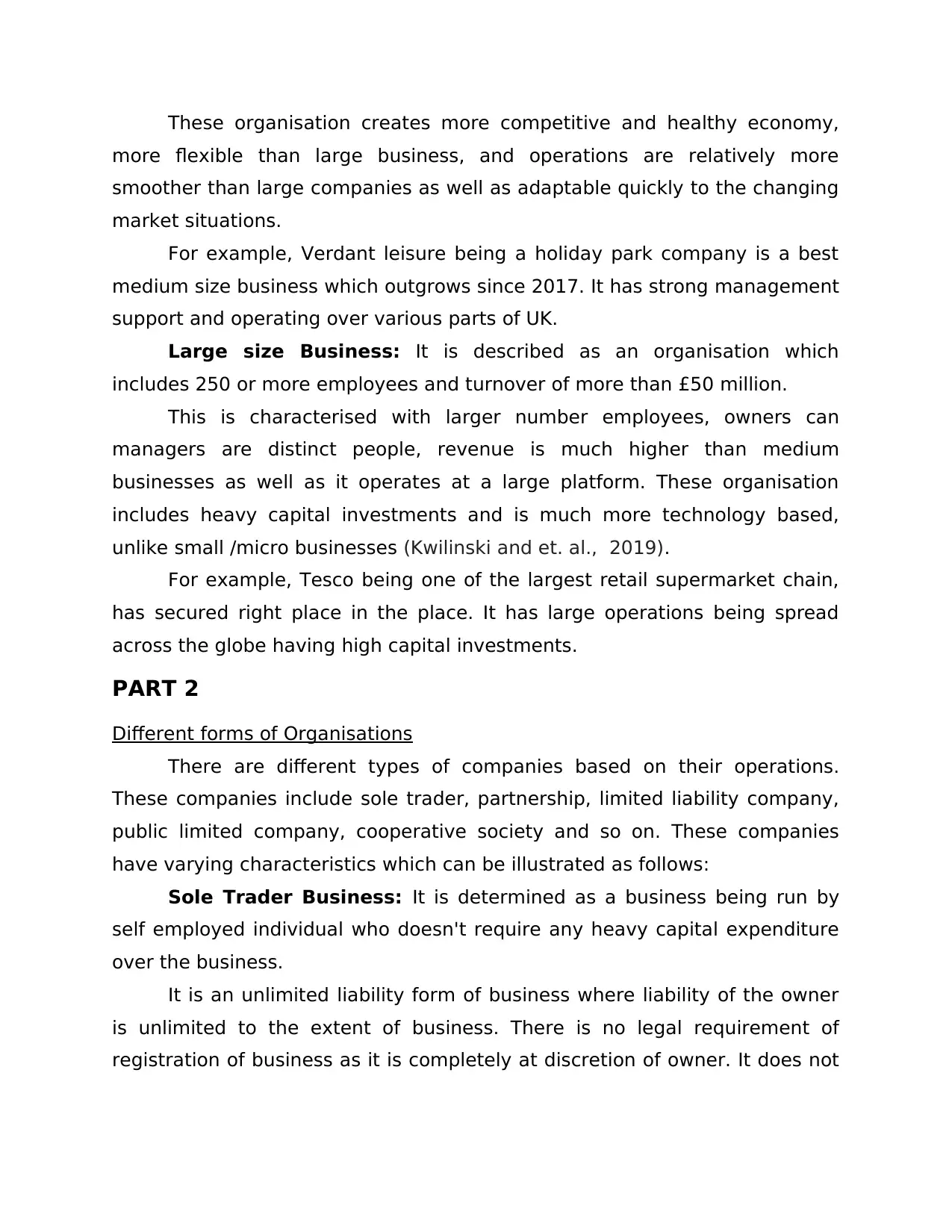
These organisation creates more competitive and healthy economy,
more flexible than large business, and operations are relatively more
smoother than large companies as well as adaptable quickly to the changing
market situations.
For example, Verdant leisure being a holiday park company is a best
medium size business which outgrows since 2017. It has strong management
support and operating over various parts of UK.
Large size Business: It is described as an organisation which
includes 250 or more employees and turnover of more than £50 million.
This is characterised with larger number employees, owners can
managers are distinct people, revenue is much higher than medium
businesses as well as it operates at a large platform. These organisation
includes heavy capital investments and is much more technology based,
unlike small /micro businesses (Kwilinski and et. al., 2019).
For example, Tesco being one of the largest retail supermarket chain,
has secured right place in the place. It has large operations being spread
across the globe having high capital investments.
PART 2
Different forms of Organisations
There are different types of companies based on their operations.
These companies include sole trader, partnership, limited liability company,
public limited company, cooperative society and so on. These companies
have varying characteristics which can be illustrated as follows:
Sole Trader Business: It is determined as a business being run by
self employed individual who doesn't require any heavy capital expenditure
over the business.
It is an unlimited liability form of business where liability of the owner
is unlimited to the extent of business. There is no legal requirement of
registration of business as it is completely at discretion of owner. It does not
more flexible than large business, and operations are relatively more
smoother than large companies as well as adaptable quickly to the changing
market situations.
For example, Verdant leisure being a holiday park company is a best
medium size business which outgrows since 2017. It has strong management
support and operating over various parts of UK.
Large size Business: It is described as an organisation which
includes 250 or more employees and turnover of more than £50 million.
This is characterised with larger number employees, owners can
managers are distinct people, revenue is much higher than medium
businesses as well as it operates at a large platform. These organisation
includes heavy capital investments and is much more technology based,
unlike small /micro businesses (Kwilinski and et. al., 2019).
For example, Tesco being one of the largest retail supermarket chain,
has secured right place in the place. It has large operations being spread
across the globe having high capital investments.
PART 2
Different forms of Organisations
There are different types of companies based on their operations.
These companies include sole trader, partnership, limited liability company,
public limited company, cooperative society and so on. These companies
have varying characteristics which can be illustrated as follows:
Sole Trader Business: It is determined as a business being run by
self employed individual who doesn't require any heavy capital expenditure
over the business.
It is an unlimited liability form of business where liability of the owner
is unlimited to the extent of business. There is no legal requirement of
registration of business as it is completely at discretion of owner. It does not
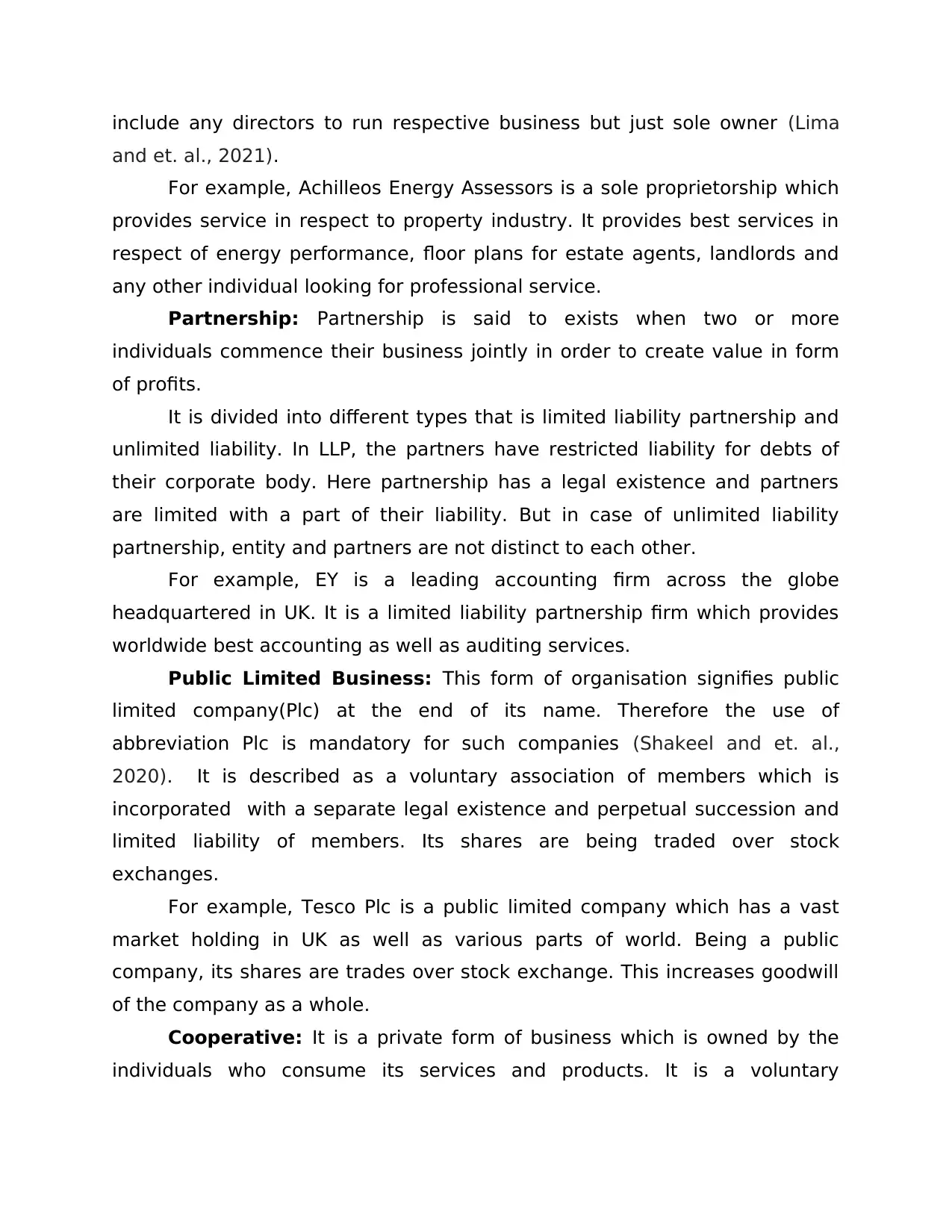
include any directors to run respective business but just sole owner (Lima
and et. al., 2021).
For example, Achilleos Energy Assessors is a sole proprietorship which
provides service in respect to property industry. It provides best services in
respect of energy performance, floor plans for estate agents, landlords and
any other individual looking for professional service.
Partnership: Partnership is said to exists when two or more
individuals commence their business jointly in order to create value in form
of profits.
It is divided into different types that is limited liability partnership and
unlimited liability. In LLP, the partners have restricted liability for debts of
their corporate body. Here partnership has a legal existence and partners
are limited with a part of their liability. But in case of unlimited liability
partnership, entity and partners are not distinct to each other.
For example, EY is a leading accounting firm across the globe
headquartered in UK. It is a limited liability partnership firm which provides
worldwide best accounting as well as auditing services.
Public Limited Business: This form of organisation signifies public
limited company(Plc) at the end of its name. Therefore the use of
abbreviation Plc is mandatory for such companies (Shakeel and et. al.,
2020). It is described as a voluntary association of members which is
incorporated with a separate legal existence and perpetual succession and
limited liability of members. Its shares are being traded over stock
exchanges.
For example, Tesco Plc is a public limited company which has a vast
market holding in UK as well as various parts of world. Being a public
company, its shares are trades over stock exchange. This increases goodwill
of the company as a whole.
Cooperative: It is a private form of business which is owned by the
individuals who consume its services and products. It is a voluntary
and et. al., 2021).
For example, Achilleos Energy Assessors is a sole proprietorship which
provides service in respect to property industry. It provides best services in
respect of energy performance, floor plans for estate agents, landlords and
any other individual looking for professional service.
Partnership: Partnership is said to exists when two or more
individuals commence their business jointly in order to create value in form
of profits.
It is divided into different types that is limited liability partnership and
unlimited liability. In LLP, the partners have restricted liability for debts of
their corporate body. Here partnership has a legal existence and partners
are limited with a part of their liability. But in case of unlimited liability
partnership, entity and partners are not distinct to each other.
For example, EY is a leading accounting firm across the globe
headquartered in UK. It is a limited liability partnership firm which provides
worldwide best accounting as well as auditing services.
Public Limited Business: This form of organisation signifies public
limited company(Plc) at the end of its name. Therefore the use of
abbreviation Plc is mandatory for such companies (Shakeel and et. al.,
2020). It is described as a voluntary association of members which is
incorporated with a separate legal existence and perpetual succession and
limited liability of members. Its shares are being traded over stock
exchanges.
For example, Tesco Plc is a public limited company which has a vast
market holding in UK as well as various parts of world. Being a public
company, its shares are trades over stock exchange. This increases goodwill
of the company as a whole.
Cooperative: It is a private form of business which is owned by the
individuals who consume its services and products. It is a voluntary
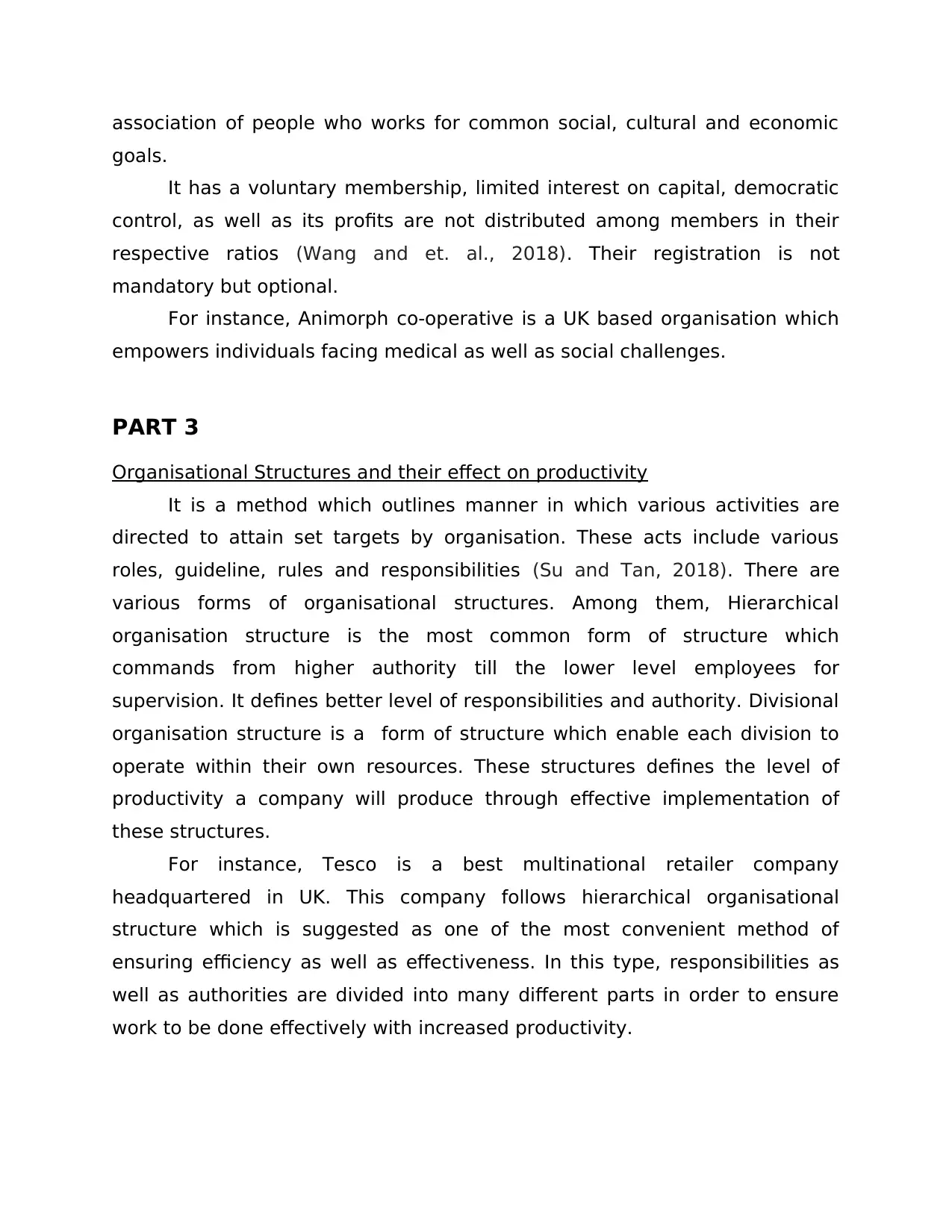
association of people who works for common social, cultural and economic
goals.
It has a voluntary membership, limited interest on capital, democratic
control, as well as its profits are not distributed among members in their
respective ratios (Wang and et. al., 2018). Their registration is not
mandatory but optional.
For instance, Animorph co-operative is a UK based organisation which
empowers individuals facing medical as well as social challenges.
PART 3
Organisational Structures and their effect on productivity
It is a method which outlines manner in which various activities are
directed to attain set targets by organisation. These acts include various
roles, guideline, rules and responsibilities (Su and Tan, 2018). There are
various forms of organisational structures. Among them, Hierarchical
organisation structure is the most common form of structure which
commands from higher authority till the lower level employees for
supervision. It defines better level of responsibilities and authority. Divisional
organisation structure is a form of structure which enable each division to
operate within their own resources. These structures defines the level of
productivity a company will produce through effective implementation of
these structures.
For instance, Tesco is a best multinational retailer company
headquartered in UK. This company follows hierarchical organisational
structure which is suggested as one of the most convenient method of
ensuring efficiency as well as effectiveness. In this type, responsibilities as
well as authorities are divided into many different parts in order to ensure
work to be done effectively with increased productivity.
goals.
It has a voluntary membership, limited interest on capital, democratic
control, as well as its profits are not distributed among members in their
respective ratios (Wang and et. al., 2018). Their registration is not
mandatory but optional.
For instance, Animorph co-operative is a UK based organisation which
empowers individuals facing medical as well as social challenges.
PART 3
Organisational Structures and their effect on productivity
It is a method which outlines manner in which various activities are
directed to attain set targets by organisation. These acts include various
roles, guideline, rules and responsibilities (Su and Tan, 2018). There are
various forms of organisational structures. Among them, Hierarchical
organisation structure is the most common form of structure which
commands from higher authority till the lower level employees for
supervision. It defines better level of responsibilities and authority. Divisional
organisation structure is a form of structure which enable each division to
operate within their own resources. These structures defines the level of
productivity a company will produce through effective implementation of
these structures.
For instance, Tesco is a best multinational retailer company
headquartered in UK. This company follows hierarchical organisational
structure which is suggested as one of the most convenient method of
ensuring efficiency as well as effectiveness. In this type, responsibilities as
well as authorities are divided into many different parts in order to ensure
work to be done effectively with increased productivity.
Paraphrase This Document
Need a fresh take? Get an instant paraphrase of this document with our AI Paraphraser
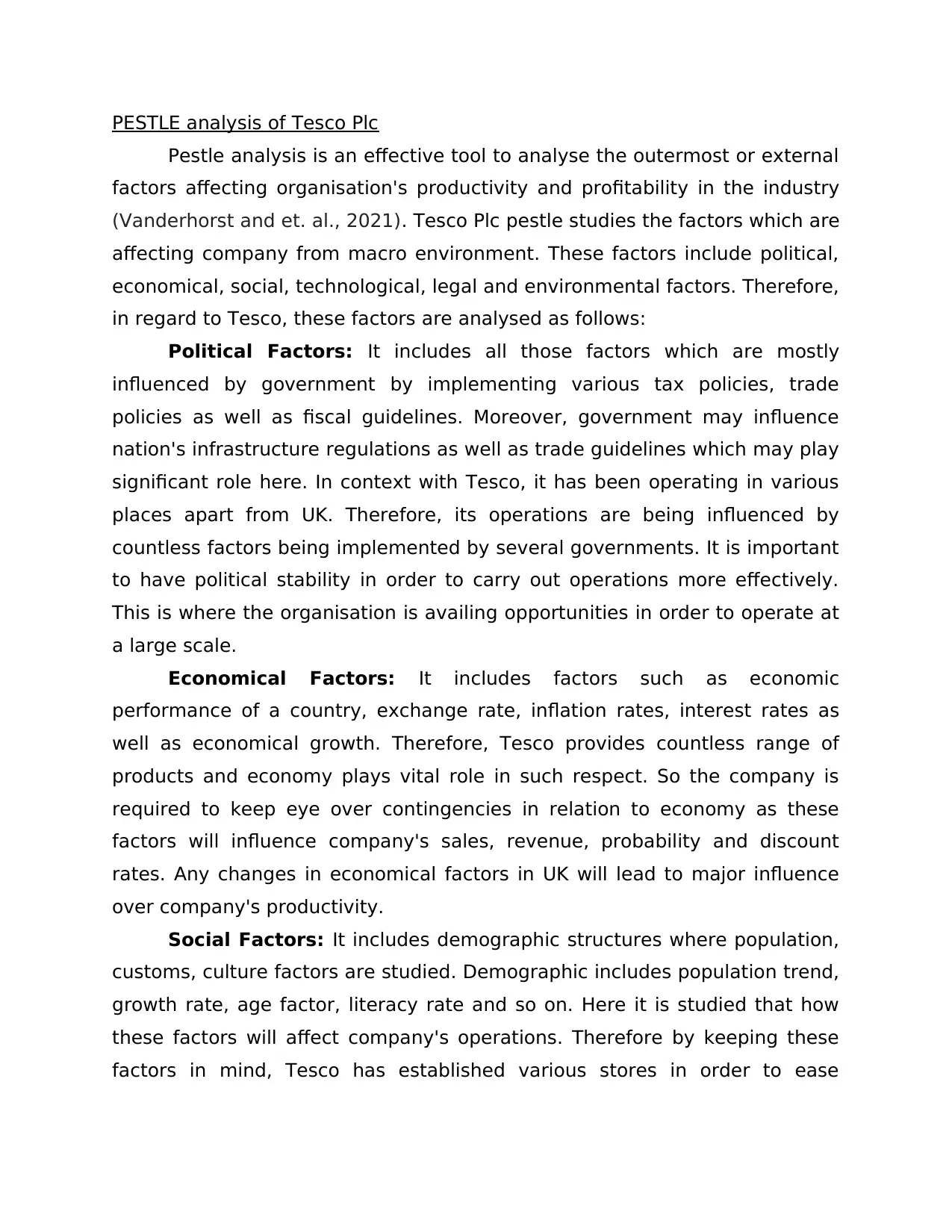
PESTLE analysis of Tesco Plc
Pestle analysis is an effective tool to analyse the outermost or external
factors affecting organisation's productivity and profitability in the industry
(Vanderhorst and et. al., 2021). Tesco Plc pestle studies the factors which are
affecting company from macro environment. These factors include political,
economical, social, technological, legal and environmental factors. Therefore,
in regard to Tesco, these factors are analysed as follows:
Political Factors: It includes all those factors which are mostly
influenced by government by implementing various tax policies, trade
policies as well as fiscal guidelines. Moreover, government may influence
nation's infrastructure regulations as well as trade guidelines which may play
significant role here. In context with Tesco, it has been operating in various
places apart from UK. Therefore, its operations are being influenced by
countless factors being implemented by several governments. It is important
to have political stability in order to carry out operations more effectively.
This is where the organisation is availing opportunities in order to operate at
a large scale.
Economical Factors: It includes factors such as economic
performance of a country, exchange rate, inflation rates, interest rates as
well as economical growth. Therefore, Tesco provides countless range of
products and economy plays vital role in such respect. So the company is
required to keep eye over contingencies in relation to economy as these
factors will influence company's sales, revenue, probability and discount
rates. Any changes in economical factors in UK will lead to major influence
over company's productivity.
Social Factors: It includes demographic structures where population,
customs, culture factors are studied. Demographic includes population trend,
growth rate, age factor, literacy rate and so on. Here it is studied that how
these factors will affect company's operations. Therefore by keeping these
factors in mind, Tesco has established various stores in order to ease
Pestle analysis is an effective tool to analyse the outermost or external
factors affecting organisation's productivity and profitability in the industry
(Vanderhorst and et. al., 2021). Tesco Plc pestle studies the factors which are
affecting company from macro environment. These factors include political,
economical, social, technological, legal and environmental factors. Therefore,
in regard to Tesco, these factors are analysed as follows:
Political Factors: It includes all those factors which are mostly
influenced by government by implementing various tax policies, trade
policies as well as fiscal guidelines. Moreover, government may influence
nation's infrastructure regulations as well as trade guidelines which may play
significant role here. In context with Tesco, it has been operating in various
places apart from UK. Therefore, its operations are being influenced by
countless factors being implemented by several governments. It is important
to have political stability in order to carry out operations more effectively.
This is where the organisation is availing opportunities in order to operate at
a large scale.
Economical Factors: It includes factors such as economic
performance of a country, exchange rate, inflation rates, interest rates as
well as economical growth. Therefore, Tesco provides countless range of
products and economy plays vital role in such respect. So the company is
required to keep eye over contingencies in relation to economy as these
factors will influence company's sales, revenue, probability and discount
rates. Any changes in economical factors in UK will lead to major influence
over company's productivity.
Social Factors: It includes demographic structures where population,
customs, culture factors are studied. Demographic includes population trend,
growth rate, age factor, literacy rate and so on. Here it is studied that how
these factors will affect company's operations. Therefore by keeping these
factors in mind, Tesco has established various stores in order to ease
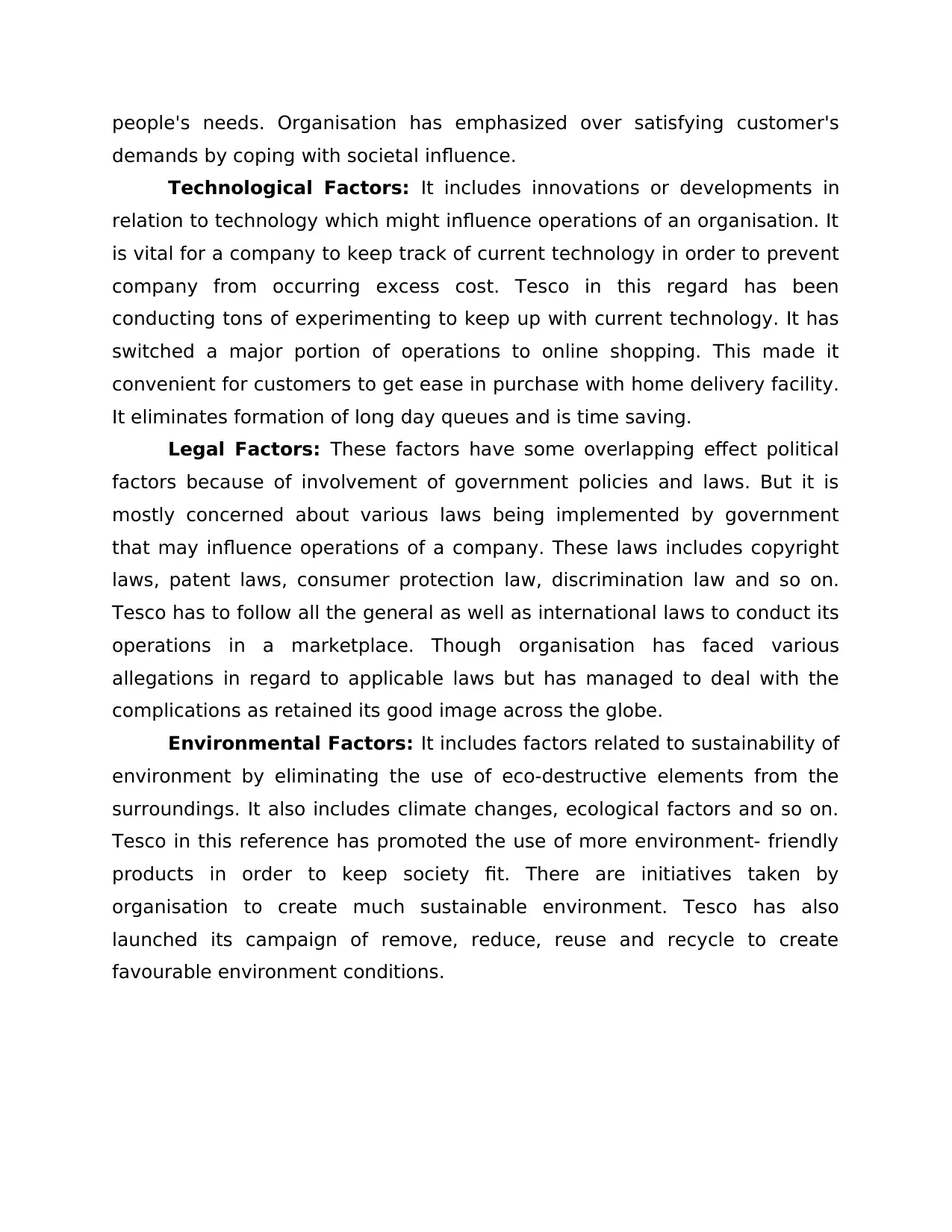
people's needs. Organisation has emphasized over satisfying customer's
demands by coping with societal influence.
Technological Factors: It includes innovations or developments in
relation to technology which might influence operations of an organisation. It
is vital for a company to keep track of current technology in order to prevent
company from occurring excess cost. Tesco in this regard has been
conducting tons of experimenting to keep up with current technology. It has
switched a major portion of operations to online shopping. This made it
convenient for customers to get ease in purchase with home delivery facility.
It eliminates formation of long day queues and is time saving.
Legal Factors: These factors have some overlapping effect political
factors because of involvement of government policies and laws. But it is
mostly concerned about various laws being implemented by government
that may influence operations of a company. These laws includes copyright
laws, patent laws, consumer protection law, discrimination law and so on.
Tesco has to follow all the general as well as international laws to conduct its
operations in a marketplace. Though organisation has faced various
allegations in regard to applicable laws but has managed to deal with the
complications as retained its good image across the globe.
Environmental Factors: It includes factors related to sustainability of
environment by eliminating the use of eco-destructive elements from the
surroundings. It also includes climate changes, ecological factors and so on.
Tesco in this reference has promoted the use of more environment- friendly
products in order to keep society fit. There are initiatives taken by
organisation to create much sustainable environment. Tesco has also
launched its campaign of remove, reduce, reuse and recycle to create
favourable environment conditions.
demands by coping with societal influence.
Technological Factors: It includes innovations or developments in
relation to technology which might influence operations of an organisation. It
is vital for a company to keep track of current technology in order to prevent
company from occurring excess cost. Tesco in this regard has been
conducting tons of experimenting to keep up with current technology. It has
switched a major portion of operations to online shopping. This made it
convenient for customers to get ease in purchase with home delivery facility.
It eliminates formation of long day queues and is time saving.
Legal Factors: These factors have some overlapping effect political
factors because of involvement of government policies and laws. But it is
mostly concerned about various laws being implemented by government
that may influence operations of a company. These laws includes copyright
laws, patent laws, consumer protection law, discrimination law and so on.
Tesco has to follow all the general as well as international laws to conduct its
operations in a marketplace. Though organisation has faced various
allegations in regard to applicable laws but has managed to deal with the
complications as retained its good image across the globe.
Environmental Factors: It includes factors related to sustainability of
environment by eliminating the use of eco-destructive elements from the
surroundings. It also includes climate changes, ecological factors and so on.
Tesco in this reference has promoted the use of more environment- friendly
products in order to keep society fit. There are initiatives taken by
organisation to create much sustainable environment. Tesco has also
launched its campaign of remove, reduce, reuse and recycle to create
favourable environment conditions.
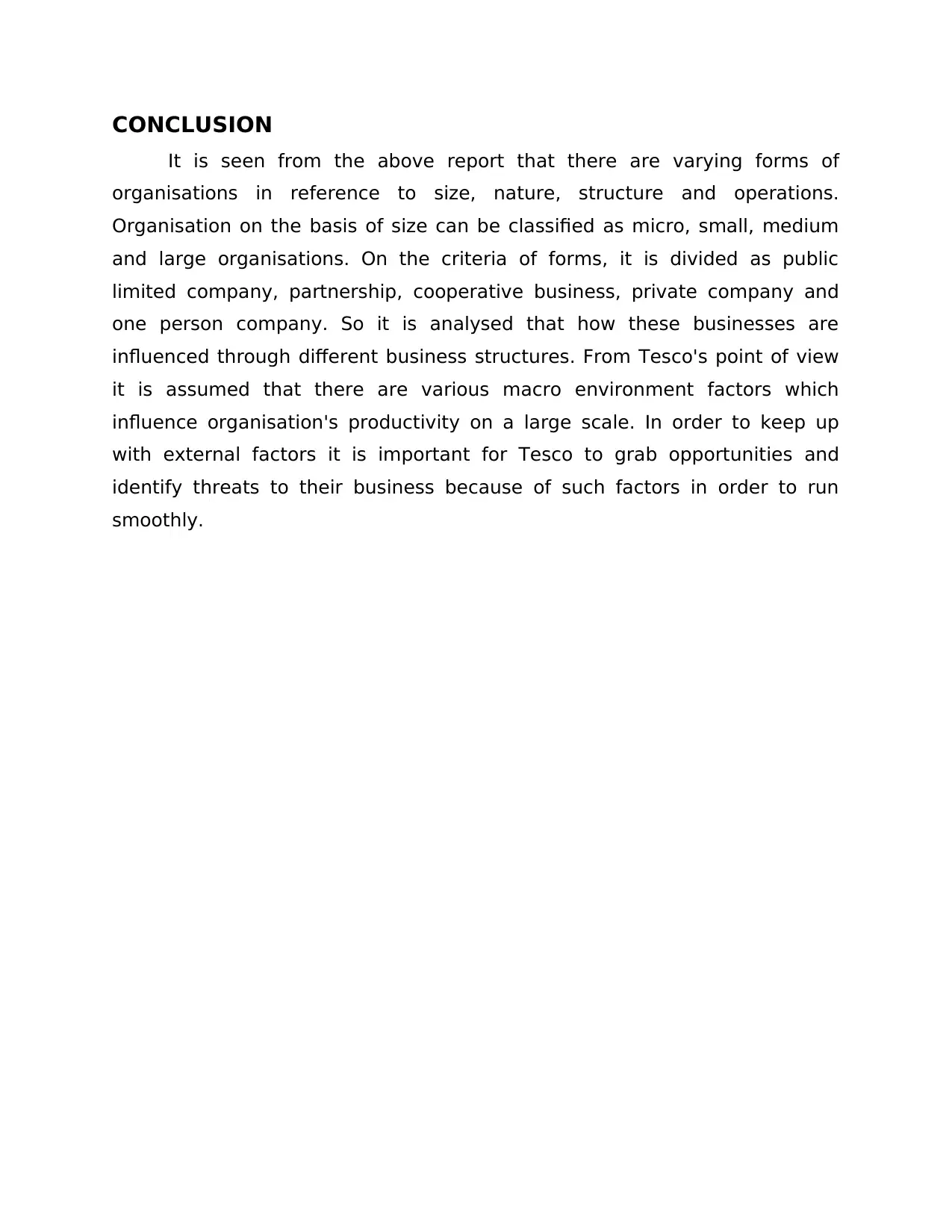
CONCLUSION
It is seen from the above report that there are varying forms of
organisations in reference to size, nature, structure and operations.
Organisation on the basis of size can be classified as micro, small, medium
and large organisations. On the criteria of forms, it is divided as public
limited company, partnership, cooperative business, private company and
one person company. So it is analysed that how these businesses are
influenced through different business structures. From Tesco's point of view
it is assumed that there are various macro environment factors which
influence organisation's productivity on a large scale. In order to keep up
with external factors it is important for Tesco to grab opportunities and
identify threats to their business because of such factors in order to run
smoothly.
It is seen from the above report that there are varying forms of
organisations in reference to size, nature, structure and operations.
Organisation on the basis of size can be classified as micro, small, medium
and large organisations. On the criteria of forms, it is divided as public
limited company, partnership, cooperative business, private company and
one person company. So it is analysed that how these businesses are
influenced through different business structures. From Tesco's point of view
it is assumed that there are various macro environment factors which
influence organisation's productivity on a large scale. In order to keep up
with external factors it is important for Tesco to grab opportunities and
identify threats to their business because of such factors in order to run
smoothly.
Secure Best Marks with AI Grader
Need help grading? Try our AI Grader for instant feedback on your assignments.
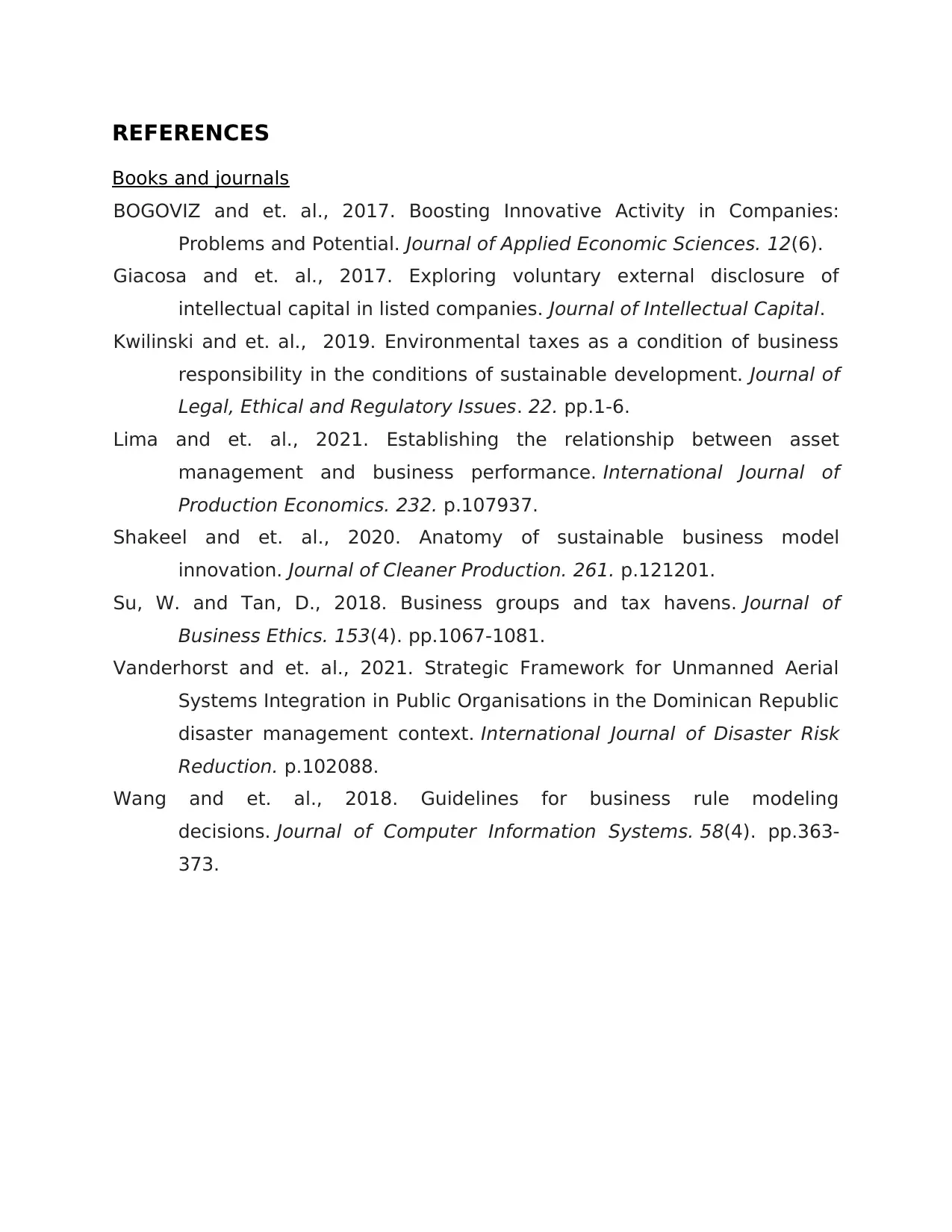
REFERENCES
Books and journals
BOGOVIZ and et. al., 2017. Boosting Innovative Activity in Companies:
Problems and Potential. Journal of Applied Economic Sciences. 12(6).
Giacosa and et. al., 2017. Exploring voluntary external disclosure of
intellectual capital in listed companies. Journal of Intellectual Capital.
Kwilinski and et. al., 2019. Environmental taxes as a condition of business
responsibility in the conditions of sustainable development. Journal of
Legal, Ethical and Regulatory Issues. 22. pp.1-6.
Lima and et. al., 2021. Establishing the relationship between asset
management and business performance. International Journal of
Production Economics. 232. p.107937.
Shakeel and et. al., 2020. Anatomy of sustainable business model
innovation. Journal of Cleaner Production. 261. p.121201.
Su, W. and Tan, D., 2018. Business groups and tax havens. Journal of
Business Ethics. 153(4). pp.1067-1081.
Vanderhorst and et. al., 2021. Strategic Framework for Unmanned Aerial
Systems Integration in Public Organisations in the Dominican Republic
disaster management context. International Journal of Disaster Risk
Reduction. p.102088.
Wang and et. al., 2018. Guidelines for business rule modeling
decisions. Journal of Computer Information Systems. 58(4). pp.363-
373.
Books and journals
BOGOVIZ and et. al., 2017. Boosting Innovative Activity in Companies:
Problems and Potential. Journal of Applied Economic Sciences. 12(6).
Giacosa and et. al., 2017. Exploring voluntary external disclosure of
intellectual capital in listed companies. Journal of Intellectual Capital.
Kwilinski and et. al., 2019. Environmental taxes as a condition of business
responsibility in the conditions of sustainable development. Journal of
Legal, Ethical and Regulatory Issues. 22. pp.1-6.
Lima and et. al., 2021. Establishing the relationship between asset
management and business performance. International Journal of
Production Economics. 232. p.107937.
Shakeel and et. al., 2020. Anatomy of sustainable business model
innovation. Journal of Cleaner Production. 261. p.121201.
Su, W. and Tan, D., 2018. Business groups and tax havens. Journal of
Business Ethics. 153(4). pp.1067-1081.
Vanderhorst and et. al., 2021. Strategic Framework for Unmanned Aerial
Systems Integration in Public Organisations in the Dominican Republic
disaster management context. International Journal of Disaster Risk
Reduction. p.102088.
Wang and et. al., 2018. Guidelines for business rule modeling
decisions. Journal of Computer Information Systems. 58(4). pp.363-
373.
1 out of 11
Related Documents
Your All-in-One AI-Powered Toolkit for Academic Success.
+13062052269
info@desklib.com
Available 24*7 on WhatsApp / Email
![[object Object]](/_next/static/media/star-bottom.7253800d.svg)
Unlock your academic potential
© 2024 | Zucol Services PVT LTD | All rights reserved.





